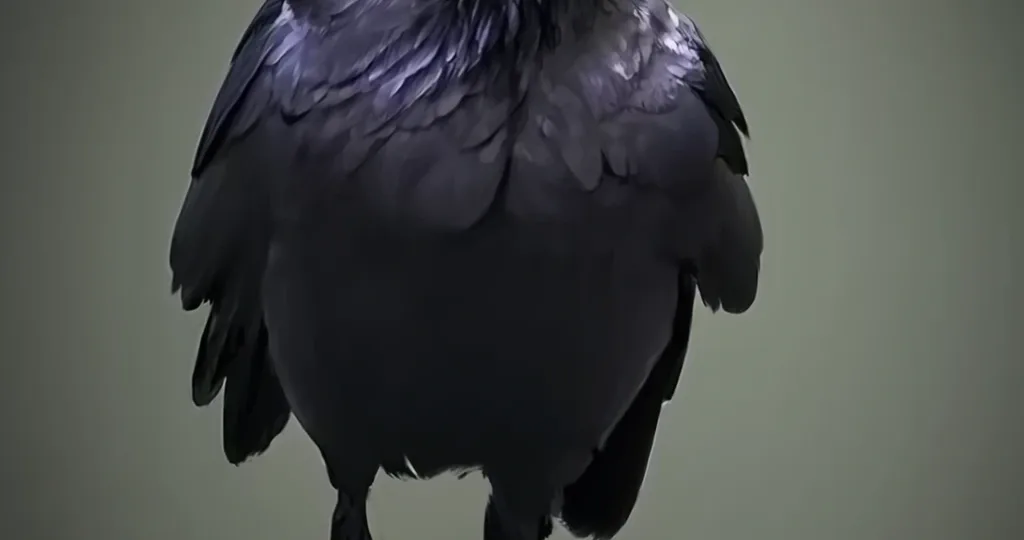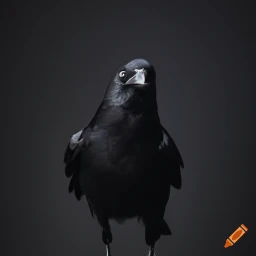Meet the Little Crow: Corvus Bennetti, Australias Feathered Friend
December 30, 2023 | by BlackCrow.com

Introducing the Little Crow: Corvus Bennetti
Meet the Little Crow
The Little Crow, scientifically known as Corvus bennetti, is a fascinating bird species that calls Australia its home. Despite its name, this small crow is not to be underestimated. Known for its intelligence and adaptability, the Little Crow has captured the hearts of bird enthusiasts and nature lovers alike.
A Feathered Friend from Australia
The Little Crow is native to Australia, where it can be found in various regions across the country. This bird species is particularly prevalent in the southern and eastern parts of Australia, including coastal areas. Its habitat ranges from woodlands and open forests to urban areas, making it a versatile and adaptable species.
With its glossy black plumage, the Little Crow stands out in its surroundings. It measures around 40 centimeters (15.7 inches) in length, making it relatively smaller compared to other crow species. Despite its small size, the Little Crow possesses remarkable characteristics that set it apart.
To learn more about other crow species, check out our articles on corvus albus – pied crow (central African coasts to southern Africa), corvus capensis – cape crow or cape rook (eastern and southern Africa), corvus brachyrhynchos – American crow (United States, southern Canada, northern Mexico), corvus cornix – hooded crow (northern and eastern Europe and northern Africa and Middle East), and corvus corone – carrion crow (Europe and eastern Asia).
The Little Crow is known for its resourcefulness and adaptability. It has successfully adapted to urban environments, where it can be observed scavenging for food and nesting in trees or buildings. This ability to thrive in various habitats has contributed to the widespread distribution of the Little Crow across Australia.
Stay tuned for more information about the appearance, characteristics, habitat, behavior, and conservation status of the Little Crow. Discover the fascinating world of this feathered friend and gain a deeper appreciation for the avian wonders that Australia has to offer.
Appearance and Characteristics
The little crow, scientifically known as Corvus bennetti, is a fascinating bird species native to Australia. Let’s explore its size, coloration, and unique features that make it stand out in the avian world.
Size and Coloration
The little crow is a medium-sized bird, measuring approximately 40-45 centimeters (15.7-17.7 inches) in length. It has a sleek and streamlined body, which aids in its flight agility. Despite its name, the little crow is not significantly smaller than other crow species.
In terms of coloration, the little crow exhibits a predominantly glossy black plumage. Its feathers have a shiny appearance, reflecting different hues of blue and purple when caught in the sunlight. This distinctive coloration adds to its aesthetic appeal and makes it easily recognizable.
Unique Features of Corvus Bennetti
While the little crow shares some similarities with other crow species, it possesses several unique features that set it apart.
One prominent feature is its beak, which is slightly curved and robust. The beak is well-suited for the little crow’s omnivorous diet, allowing it to efficiently extract food from various sources. From insects and fruits to seeds and carrion, the little crow is an opportunistic feeder.
Another notable characteristic of the little crow is its intelligent nature. Crows, in general, are known for their problem-solving abilities and adaptability. The little crow exhibits remarkable cognitive skills, using tools to access food and displaying complex social behaviors within its flock.
The little crow’s vocalizations are also distinct. It communicates through a range of calls, including harsh caws and melodic notes. These vocalizations serve various purposes, such as establishing territory, warning of potential threats, or communicating with other members of its group.
Understanding the appearance and characteristics of the little crow provides a deeper appreciation for this unique bird species. In the following sections, we will explore its habitat, behavior, and conservation status to gain a comprehensive understanding of its place in the natural world.
Habitat and Distribution
Where Can You Find Corvus Bennetti?
The Little Crow, scientifically known as Corvus bennetti, is a unique bird species found exclusively in Australia. Its habitat is primarily restricted to the northern and eastern regions of the country. Unlike some other crow species, the Little Crow does not have a widespread distribution beyond Australia.
Preferred Environments of the Little Crow
The Little Crow is adaptable to a variety of habitats within its limited range. It can be found in a range of environments, including open woodlands, grasslands, farmlands, and urban areas. These versatile birds have adjusted to human-altered landscapes and are often seen in agricultural fields, pastures, and even city parks.
Little Crows are known to form communal roosts and nesting colonies in areas with suitable vegetation and food sources. They are highly adaptable and can thrive in both natural and anthropogenic landscapes, making them a common sight in many parts of Australia.
To learn more about other crow species found around the world, such as the Pied Crow in Africa or the American Crow in North America, you can explore our informative articles.
Understanding the habitat and distribution of the Little Crow helps us appreciate the unique ecological niche this bird occupies within the diverse avian fauna of Australia.
Behavior and Diet
When it comes to behavior and diet, the little crow, scientifically known as Corvus bennetti, showcases interesting traits and feeding habits.
Social Interactions
Little crows are highly social birds and can often be found in large flocks. They engage in various social interactions, including vocalizations and intricate aerial displays. These displays involve synchronized flying patterns, acrobatic maneuvers, and even mid-air food exchanges. These behaviors help strengthen social bonds within the flock and establish dominance hierarchies.
Within the flock, little crows exhibit cooperative breeding, where multiple individuals participate in raising the young. This cooperative behavior ensures the survival and well-being of the offspring. Additionally, little crows are known to form mixed-species flocks, often associating with other bird species for foraging and protection.
Feeding Habits of Corvus Bennetti
Little crows have an omnivorous diet, which means they consume a variety of food items. Their diet primarily consists of insects, fruits, seeds, and small vertebrates. They are skilled foragers and use their sharp beaks to extract insects from the ground or tree bark.
Little crows also display clever feeding techniques. For example, they have been observed using tools such as sticks or twigs to extract insects from tree crevices. This behavior demonstrates their problem-solving abilities and adaptability in obtaining food.
In addition to insects, little crows have been known to raid crops, particularly during the harvest season. This behavior can lead to conflicts with farmers, as the crows can cause damage to agricultural fields. However, it’s important to note that the impact of little crows on crop yield is generally minimal and can be managed through various non-lethal methods, such as scare tactics and deterrents.
By understanding the social interactions and feeding habits of little crows, we can appreciate the fascinating behaviors exhibited by these feathered friends from Australia.
Conservation Status
Threats to the Little Crow
The Little Crow (Corvus bennetti) faces several threats to its survival. One of the primary threats is habitat loss and degradation. As human activities expand and modify the landscapes where the Little Crow resides, their natural habitats are being destroyed or fragmented. This loss of suitable habitat limits the crow’s nesting sites, foraging areas, and overall ability to find food and shelter.
Another significant threat to the Little Crow is the introduction of invasive species. Predatory animals such as cats and foxes have been introduced to parts of Australia where the Little Crow is found. These predators pose a threat to the crows and their nests, impacting their breeding success and population numbers.
Additionally, climate change poses a potential threat to the Little Crow. Changes in temperature, rainfall patterns, and extreme weather events can disrupt the crow’s breeding cycles, alter food availability, and impact their overall survival.
Conservation Efforts
Efforts are underway to protect and conserve the Little Crow. Conservation organizations, researchers, and local communities are working together to address the threats faced by this species.
One of the key conservation strategies is the preservation and restoration of suitable habitats for the Little Crow. This includes protecting and managing areas of native vegetation, such as woodlands and grasslands, which are important for the crow’s nesting and foraging activities.
In addition to habitat conservation, predator control programs are being implemented to reduce the impact of invasive species on the Little Crow population. These programs involve the removal or control of feral cats, foxes, and other predators that pose a threat to the crows and their nests.
Public awareness and education campaigns are also playing a vital role in the conservation of the Little Crow. By raising awareness about the importance of protecting this species and its habitat, these initiatives aim to foster a sense of stewardship and encourage actions that support their survival.
Research and monitoring efforts are underway to better understand the population dynamics, behavior, and specific conservation needs of the Little Crow. This knowledge is essential for developing effective conservation strategies and ensuring the long-term survival of this unique and charismatic bird.
Through a combination of habitat preservation, predator control, public awareness, and ongoing research, conservationists are striving to safeguard the future of the Little Crow and ensure that this feathered friend continues to grace the Australian skies for generations to come.
Fun Facts about Corvus Bennetti
Discover some interesting trivia and fascinating behaviors of the Little Crow, also known as Corvus Bennetti.
Interesting Trivia
- The Little Crow, scientifically known as Corvus Bennetti, is a species of crow native to Australia.
- It belongs to the Corvidae family, which includes other intelligent and sociable birds like ravens and magpies.
- The Little Crow is one of the smallest crow species, measuring about 36-42 centimeters (14-17 inches) in length.
- Despite its small size, this feathered friend is known for its distinctive loud and melodic calls that can be heard echoing through its habitat.
- The plumage of the Little Crow is predominantly black, with a glossy sheen that adds to its beauty.
- Unlike some other crow species, the Little Crow does not display significant sexual dimorphism, meaning males and females look very similar.
Fascinating Behaviors of the Little Crow
- Little Crows are highly social birds and are often seen in small to large groups, known as flocks or murders. These flocks can consist of a few individuals to hundreds of birds.
- They are intelligent creatures and exhibit problem-solving skills, such as using tools to extract food from hard-to-reach places.
- Little Crows are opportunistic feeders and have a diverse diet. They scavenge for carrion, insects, fruits, seeds, and even small vertebrates.
- These birds are known for their agility and acrobatic flight patterns. They can perform intricate aerial maneuvers, including mid-air somersaults and barrel rolls.
- The breeding season for Little Crows typically occurs between August and December. During this time, they build nests in trees using sticks, twigs, and other materials.
- Interestingly, Little Crows are known to engage in cooperative breeding, where non-breeding individuals assist in raising the offspring of the breeding pair.
- They are adaptable birds and can thrive in various habitats, including woodlands, coastal areas, and urban environments.
These fun facts provide a glimpse into the intriguing world of the Little Crow, showcasing its unique characteristics and behaviors. Observing these intelligent and sociable birds in their natural habitat can be a delight for bird enthusiasts and nature lovers alike.
RELATED POSTS
View all


